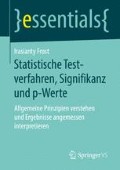Zusammenfassung
Einen statistischen Test durchzuführen ist technisch ohne großen Aufwand möglich. Es gibt genügend Statistik-Software, die uns automatisch Ergebnisse liefert. Die theoretischen Grundlagen muss man nicht (ganz) verstehen. Selbst händisch ist die Berechnung mühelos; man muss lediglich den Arbeitsschritten, die in Lehrbüchern zu finden sind, rezeptartig folgen. Mangelndes Verständnis kann jedoch dazu führen, dass Ergebnisse falsch interpretiert werden.
Access this chapter
Tax calculation will be finalised at checkout
Purchases are for personal use only
Notes
- 1.
Wir meiden jedoch diesen Begriff, da die Gefahr besteht, diesen mit Fishers Signifikanztest zu verwechseln. Fishers „tests of significance“ bauen auf einem anderen Inferenzverständnis auf als klassische Tests von Neyman und Pearson (siehe zum Beispiel Lehmann 2011). Stattdessen folgen wir Rüger (1996, 2002a, b) und sprechen von Niveau-α-Tests oder einfach von statistischen Tests.
Literatur
Beck-Bornholdt H-P, Dubben H-H (2001) Der Schein der Weisen. Hoffmann und Campe, Hamburg
Bortz J, Lienert GA (2008) Verteilungsfreie Methoden in der Biostatistik. 3. Aufl. Springer, Heidelberg
Bortz J, Schuster C (2010) Statistik für Human- und Sozialwissenschaftler. 7. Aufl. Springer, Heidelberg
Brigg WM (2012) It is time to stop teaching frequentism to non-statisticians. http://arxiv.org/abs/1201.2590. Zugegriffen am 05.01.2016
Caputo A, Graf E (2008) Planung einer klinischen Studie: Wie viele Patienten sind notwendig? In: Schumacher M, Schulgen G (Hrsg.) Methodik klinischer Studien. 3. Aufl. Springer, Heidelberg, 171–193
Cumming G (2006) Meta-Aalysis: Pictures that explain how experimental findings can be integrated. In: International conference on teaching statistics, ICOTS-7. https://www.stat.auckland.ac.nz/~iase/publications/17/C105.pdf. Zugegriffen am 29.08.2016
Fahrmeir L, Künstler R, Pigeot I, Tutz G (2011) Statistik. Der Weg zur Datenanalyse. 7. Aufl. Springer, Heidelberg
Field A (2014) Discovering statistics using IBM SPSS STATISTICS, 4. Aufl. SAGE Publication
Field A, Hole G (2003) How to design and report experiments. SAGE Publications, London
Fisher RA (1935) The logic of inductive inference. J R Stat Soc 98:39–54
Frost I (2015) Statistik für Wirtschaftswissenschaftler. Grundlagen und praktische Anwendungen. 2. Aufl. expert verlag
Gigerenzer G (2004) Mindless statistics. J Socio-Econ 33:587–606
Gornick L, Smith W (2005) The cartoon guide to statistics. HarperCollins, New York
Haller H, Krauss S (2002) Misinterpretations of significance: a problem students share with their teachers? Method Psychol Res Online 7(1). https://www.mpr-online.de. Zugegriffen am 09.12.2016
Hubbard R, Bayarri MJ (2003) Confusion over measures of evidence (p’s) versus errors (α’s) in classical statistical testing. Am Stat 57(3):171–182
Levine TR, Weber, R, Hullet C, Hee SP, Massi Lindsey LL (2008) A critical assesment of null hypothesis significance testing in quantitative communication research. Hum Commun Res 34:171–187
Lehmann EL (1993) The Fisher, Neyman-Pearson theories of testing hypotheses: one theory or two? J Am Stat Assoc 88(424):242–1249
Lehmann EL (2011) Fisher, Neyman, and the creation of classical statistics. Springer, New York
Lenhard J (2006) Models and statistical inference: the controversy between Fisher and Neyman-Pearson. Br J Philos Sci 57:69–91
Louçã F (2008) Should the widest cleft in statistics – how and why Fisher opposed Neyman and Pearson. Working papers, school of economics and management. Technical University of Lisbon. http://pascal.iseg.utl.pt/~depeco/wp/wp022008.pdf. Zugegriffen am 20.01.2016
Meehl PE (1967) Theory-testing in psychology and physic: a methodological paradox. Philos Sci 34:103–115
Neyman J (1938) L’estimation statistique traitèe comme un probléme classique de probabilitè. Actualitès Scientifiques et Industrielles No. 739:25–57
Neyman J (1961) Silver Jubilee of my dispute with fisher. J Oper Res Soc Jpn 3(4):145–154
Neyman J, Pearson ES (1933) On the problem of the most efficient tests of statistical hypotheses. Philos Trans R Soc Lond Ser A 231:289–337
Nickerson RS (2000) Null hypothesis significance testing: a review of an old and continuing controversy. Psychol Methods 5(2):241–301
Rosnow RL, Rosenthal R (1989) Statistical procedures and the justification of knowledge in psychological science. Am Psychol 44(10):1276–1284
Rozeboom WW (1960) The fallacy of the null-hypothesis significance test. Psychol Bull 57:416–428
Rüger B (1996) Induktive Statistik. 3. Aufl. Oldenbourg
Rüger B (2002a) Test- und Schätztheorie Band I: Grundlagen. Oldenbourg
Rüger B (2002b) Test- und Schätztheorie Band II: Statistische Tests. Oldenbourg
Schwarzer G, Timmer A, Galandi D, Antes G, Schumacher M (2008) Meta-Analyse ran- domisierter klinischer Studien, Publikationsbias und evidenzbasierte Medizin. In: Schumacher M, Schulgen G (Hrsg) Methodik klinischer Studien. 3. Aufl. Springer, Heidelberg, 129–160
Steering committee of the physicians’ health study research group (1989) Final report on the aspirin component of the ongoing physicians’ health 31 study. N Engl J Med 321: 129–135
Tukey JW (1977) Exploratory data analysis. Addison-Wesley, Reading
Viechtbauer W (2010) Meta-Analyse. In: Holling H, Schmitz B (Hrsg) Handbuch Statistik, Methoden und Evaluation. Hogrefe, Göttingen, S 743–756
Weihe W (2004) Von der Wahrscheinlichkeit des Irrtums. Deutsches Ärzteblatt, 101(13): A834–A838
Author information
Authors and Affiliations
Corresponding author
Rights and permissions
Copyright information
© 2017 Springer Fachmedien Wiesbaden GmbH
About this chapter
Cite this chapter
Frost, I. (2017). Statistische Tests. In: Statistische Testverfahren, Signifikanz und p-Werte. essentials. Springer VS, Wiesbaden. https://doi.org/10.1007/978-3-658-16258-0_3
Download citation
DOI: https://doi.org/10.1007/978-3-658-16258-0_3
Published:
Publisher Name: Springer VS, Wiesbaden
Print ISBN: 978-3-658-16257-3
Online ISBN: 978-3-658-16258-0
eBook Packages: Life Science and Basic Disciplines (German Language)

